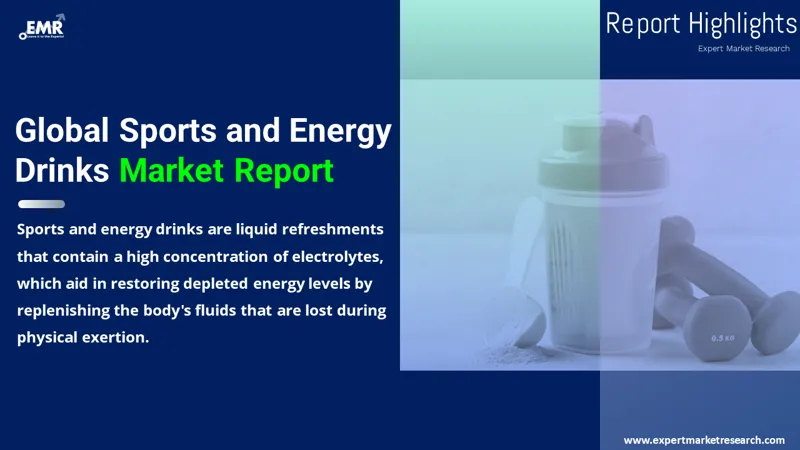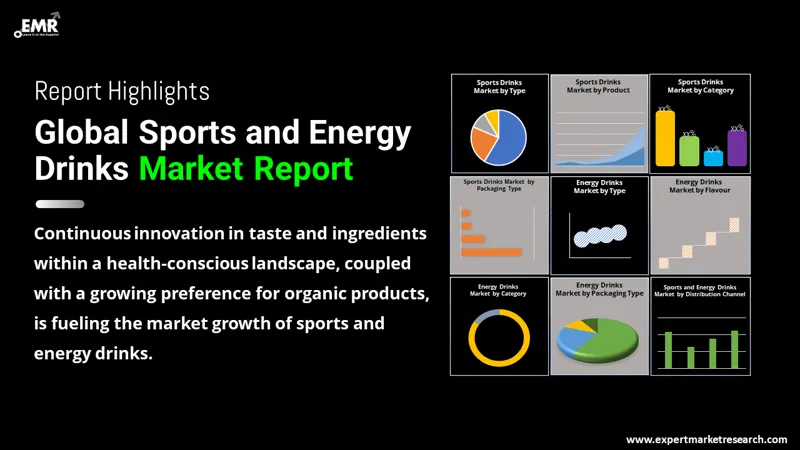
Consumer Insights
Uncover trends and behaviors shaping consumer choices today
Procurement Insights
Optimize your sourcing strategy with key market data
Industry Stats
Stay ahead with the latest trends and market analysis.
The global sports and energy drinks market attained a value of about USD 124.60 Billion in 2025. The market is further expected to grow in the forecast period of 2026-2035 at a CAGR of 7.50%, to reach nearly USD 256.80 Billion by 2035.
Base Year
Historical Period
Forecast Period
Compound Annual Growth Rate
7.5%
Value in USD Billion
2026-2035
*this image is indicative*
The market for sports and energy drinks is being driven by rising demand from teenagers and young adults. However, the demand for energy drinks is gaining popularity among the working population as well due to long and erratic work hours, hence, aiding the market growth. Consumption of energy drinks as a routine drink is thus supplementing industry growth. The popularity of energy drinks among the urban population, owing to rising income levels, urbanisation and availability in bars, are also some of the factors aiding market growth of sports and energy drinks. A demand for fewer calorie and low carbohydrates intake among the middle-aged population is strengthening the sports and energy drinks industry. A widespread distribution channel, including supermarkets and hypermarkets, e-commerce websites and convenience stores, is also expected to fuel industry growth.

Read more about this report - REQUEST FREE SAMPLE COPY IN PDF
In recent times, especially during the lockdown, the gaming and e-sport community gained prominence over outdoor activities. This is anticipated to boost the market of sports and energy drinks to provide enhanced focus and mental clarity to the targeted population. Among the Gen-Z population, the demand for clean-label, healthy products are aiding market growth owing to innovations in ingredients by sports and energy drink manufacturers. The rising awareness for health and organic products and increased consumer spending is providing opportunities for the sports and energy drinks industry.
The sports and energy drinks market is experiencing remarkable growth, driven by increasing consumer demand for hydration and energy-boosting solutions. As athletes and fitness enthusiasts seek effective ways to enhance performance and recovery, the market has expanded with a variety of products, including electrolyte-rich sports drinks and high-caffeine energy beverages. Key players are innovating with natural ingredients, appealing to health-conscious consumers who prefer clean label options. The rise of e-commerce has further transformed the landscape, providing easy access to a wide range of drinks. Additionally, social media and influencer marketing are shaping consumer preferences, promoting brands that resonate with active lifestyles. With a projected increase in market share, the sports and energy drinks sector is poised for significant expansion, catering to diverse consumer needs across various demographics.

Read more about this report - REQUEST FREE SAMPLE COPY IN PDF
Sports and energy drinks are beverages rich in electrolytes, which help in regaining energy levels by replenishing the fluid lost during physical activities. These are highly caffeinated drinks that offer additional energy and provide essential nutrients to the body. These beverages are easily available in the form of cans or bottles across various distribution channels.
By segment, the market is bifurcated into:
On the basis of type, the sports drinks market is segmented into:
Based on product, the sports drinks market is divided into:
On the basis of category, the sports and energy drinks industry is categorised into:
On the basis of packaging type, the sports and energy drinks industry is divided into:
Based on distribution channel, the sports and energy drinks industry is segmented into:
By type, the energy drinks are divided into:
On the basis of flavour, the industry is bifurcated into:
The EMR report looks into the regional markets like:
Constant innovation in the taste and ingredients of sports and energy drinks is anticipated to positively impact industry growth. As the consumers are becoming aware of what is in their drink, the market for sports and energy drinks is expected to rise with the inclusion of chemical-free, natural products. The rise in the use of natural ingredients in a health-conscious society is augmenting the market growth of sports and energy drinks. The introduction of ingredients like green tea, ginseng and pomegranate juice into sports and energy drinks have helped in increasing the anti-oxidants and polyphenol contents to make drinks healthier, is aiding the market growth. The incorporation of all-natural ingredients, vitamin and mineral fortification, natural ingredients, no-added colour formula, and fruit-based products are anticipated to drive industry growth.
The rising health consciousness among the youth, attributed to fitness activities like sports and yoga, bolster market growth. The inclusion of muscle building and endurance improving ingredients that make these drinks more functional are expected to propel the market towards growth in the coming years. The replacement of high fructose corn syrup with sucrose and fructose resulting in slow release of energy, owing to the demand for no-sugar products, is further invigorating the industry growth. Furthermore, demand for plant-based protein sources is gaining popularity among young adults is expected to aid market growth of sports and energy drinks. A shift in manufacturing practices to include soy protein, pea protein, rice protein, among other sources as their key ingredients, is providing growth opportunities for market growth.
The report presents a detailed analysis of the following key players in the global sports and energy drinks market, looking into their capacity, market share, and latest developments like capacity expansions, plant turnabouts and mergers and acquisitions:
The comprehensive report looks at the micro and macro aspects of the industry. The EMR report gives an in-depth insight into the market by providing a SWOT analysis as well as an analysis of the Porter’s Five Forces Model.




*While we strive to always give you current and accurate information, the numbers depicted on the website are indicative and may differ from the actual numbers in the main report. At Expert Market Research, we aim to bring you the latest insights and trends in the market. Using our analyses and forecasts, stakeholders can understand the market dynamics, navigate challenges, and capitalize on opportunities to make data-driven strategic decisions.*
Get in touch with us for a customized solution tailored to your unique requirements and save upto 35%!
The global sports and energy drinks market attained a value of nearly USD 124.60 Billion in 2025.
The market is projected to grow at a CAGR of 7.50% in the forecast period of 2026-2035.
The market is estimated to witness a healthy growth in the forecast period of 2026-2035 to reach about USD 256.80 Billion by 2035.
The sports and energy drinks industry is being driven by an increased demand for products to enhance focus and mental clarity owing to long and erratic working hours and expanding e-gaming applications.
Constant innovation in taste and ingredients in a health-conscious environment and a rising preference towards organic products to augment the market growth for sports and energy drinks.
The major regional markets for sports and energy drinks are North America, Latin America, the Asia Pacific, Europe, and the Middle East and Africa.
The major segments within the industry are sports drinks and energy drinks.
On the basis of type, the sports drinks market is divided into hypotonic, hypertonic and isotonic.
The significant products in the industry are organic and conventional.
Based on category, the market is segmented into regular and low calorie.
Cans and bottles, among others are the different types of packaging available for sports and energy drinks.
The significant distribution channels are supermarkets and hypermarkets, convenience stores, speciality stores, and online, among others.
The major types of energy drinks are alcoholic and non-alcoholic.
The different flavours of energy drinks are flavoured and non-flavoured.
The major players in the industry are Monster Beverage Corporation, Red Bull GmbH, Rockstar, Inc., PepsiCo, Inc., and The Coca-Cola Company, among others.
Explore our key highlights of the report and gain a concise overview of key findings, trends, and actionable insights that will empower your strategic decisions.
| REPORT FEATURES | DETAILS |
| Base Year | 2025 |
| Historical Period | 2019-2025 |
| Forecast Period | 2026-2035 |
| Scope of the Report |
Historical and Forecast Trends, Industry Drivers and Constraints, Historical and Forecast Market Analysis by Segment:
|
| Sports Drinks Market Breakup by Type |
|
| Sports Drinks Market Breakup by Product |
|
| Energy Drinks Market Breakup by Type |
|
| Energy Drinks Market Breakup by Flavour |
|
| Sports and Energy Drinks Market Breakup by Category |
|
| Sports and Energy Drinks Market Breakup by Packaging Type |
|
| Sports and Energy Drinks Market Breakup by Distribution Channel |
|
| Breakup by Region |
|
| Market Dynamics |
|
| Competitive Landscape |
|
| Companies Covered |
|
| Report Price and Purchase Option | Explore our purchase options that are best suited to your resources and industry needs. |
| Delivery Format | Delivered as an attached PDF and Excel through email, with an option of receiving an editable PPT, according to the purchase option. |
Datasheet
One User
USD 2,499
USD 2,249
tax inclusive*
Single User License
One User
USD 3,999
USD 3,599
tax inclusive*
Five User License
Five User
USD 4,999
USD 4,249
tax inclusive*
Corporate License
Unlimited Users
USD 5,999
USD 5,099
tax inclusive*
*Please note that the prices mentioned below are starting prices for each bundle type. Kindly contact our team for further details.*
Flash Bundle
Small Business Bundle
Growth Bundle
Enterprise Bundle
*Please note that the prices mentioned below are starting prices for each bundle type. Kindly contact our team for further details.*
Flash Bundle
Number of Reports: 3
20%
tax inclusive*
Small Business Bundle
Number of Reports: 5
25%
tax inclusive*
Growth Bundle
Number of Reports: 8
30%
tax inclusive*
Enterprise Bundle
Number of Reports: 10
35%
tax inclusive*
How To Order

Select License Type
Choose the right license for your needs and access rights.

Click on ‘Buy Now’
Add the report to your cart with one click and proceed to register.

Select Mode of Payment
Choose a payment option for a secure checkout. You will be redirected accordingly.
Gain insights to stay ahead and seize opportunities.

Get insights & trends for a competitive edge.

Track prices with detailed trend reports.

Analyse trade data for supply chain insights.

Leverage cost reports for smart savings

Enhance supply chain with partnerships.

Connect For More Information
Our expert team of analysts will offer full support and resolve any queries regarding the report, before and after the purchase.
Our expert team of analysts will offer full support and resolve any queries regarding the report, before and after the purchase.
We employ meticulous research methods, blending advanced analytics and expert insights to deliver accurate, actionable industry intelligence, staying ahead of competitors.
Our skilled analysts offer unparalleled competitive advantage with detailed insights on current and emerging markets, ensuring your strategic edge.
We offer an in-depth yet simplified presentation of industry insights and analysis to meet your specific requirements effectively.
Share